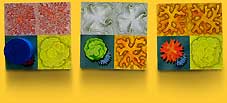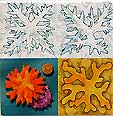Reef Encounter
page 2
| x |
|
|
|
|
|
|
|
|
|
|
|
|
|
|
|
|
|
|
|
|
|
|
|
|
|
|
 |
|
It is possible to flip over the coral tiles in order to reverse the relative strength of two colours of coral. Each coral tile shows two of the four colours of algae (these colours have nothing to do with the colour of the displayed corals!). A consumed polyp tile can be exchanged for an alga cylinder of any colour. These alga cylinders are played immediately: all coral tiles displaying that colour of alga are flipped over. |
| x |
|
|
|
|
|
|
|
|
|
|
|
|
|
|
|
|
|
|
|
|
|
|
|
|
|
|
| But there is more! A coral tile can also be fixed: the alga cylinder is then placed on top of this tile, and it can never be flipped over again! This means that the relative strength of the displayed corals cannot be reversed for the duration of the game, but it also serves another purpose: at the end of the game, every polyp tile devoured by the parrotfish scores one point, plus one point for each coral tile which shows that colour of coral as the strongest. For example, if yellow is stronger than pink, white and orange, but weaker than grey, each yellow polyp tile in the parrotfish is worth four points. So, each polyp tile eaten by the parrotfish scores between one point (if this colour is always the weakest) and five points (if this colour is stronger than all the other four colours). |
|
 |
| x |
|
|
|
|
|
|
|
|
|
|
|
|
|
|
|
|
|
|
|
|
|
|
|
|
|
|
 |
Other possible actions are introducing or moving a shrimp, and exchanging a polyp tile for a larva cube of the same colour or vice versa. The game ends when all the four shrimps of one player have been eaten by their parrotfish, or when the last coral tile is covered by an alga cylinder. All other players have one last chance to eat a coral with their parrotfish, presumed they own a coral that is large enough. Instead of the usual four polyp tiles during the game, five tiles are returned to the stock. The contents of each player’s parrotfish are scored, and the player with the highest score wins the game!
|
 |
|
|
|
|
|
|
|
|
|
|
|
|
|
|
|
|
|
|
|
|
|
|
|
As in many great games, everything is hard to get in Reef Encounter: the larva cubes and polyp tiles in the desirable colours, but especially the consumed polyp tiles that can only be obtained by attacking weaker corals. These tiles are of vital importance to exert influence on which corals are weaker and can thus be eaten, and also to ensure that the colours of corals you feed your parrotfish will be worth lots of points at the end of the game. After all, a six-tile coral of a colour worth five points is worth just as much as a 14-tile coral (!!) of a colour worth one point! A good tactic to obtain consumed polyp tiles is to place some weak tiles yourself, and attack them in the same turn with a stronger coral. Of course it’s much more fun to attack an opponent’s coral, but these are often rather well protected by a shrimp.
|
|
|
 |
| x |
|
|
|
|
|
|
|
|
|
|
|
|
|
|
|
|
|
|
|
|
|
|
|
|
|
|

 xx xx x x
|
|
Reef Encounter contains so many components that it might seem a little confusing at first. But since it is all quite logical, you will get used to it quickly and it doesn’t make the game too complicated. It is, however, a rather long game; the box says 60-120 minutes, but with four (inexperienced) players it can take considerably longer. Reef Encounter is fun, exciting, and tactical, and as usual the illustrations are great (although the grey and white corals are a bit difficult to distinguish). The game works very well with either two, three or four players. With Reef Encounter, Richard Breese has produced another great game that is more difficult and therefore more challenging than his Key-series. This game undoubtedly will make a regular appearance on our table.
© 2004 Barbara Lussenburg
Reef Encounter, Richard Breese, R&D Games, 2004, 2 to 4 players
|
  |
 |
|
|
 |
  |
|
|
  |
|
|
|
|
|
|
  |
|
|
|
|
|
|
  |
|
|
|
|
|
|
  |
|
|
|
|
|
|
| x |
|
|
|
|
|
|
| x |
|
|
|
|
|
|
 |
|
|
 |
|
|
 |
|
|
| x |
|
|
|
|
|
|
 |
|
|
|
|
|
|
|
|
|
|
|
|
|
|
|
|
 |
|
|
|
|
|
|
|
|
|
|
|
|
|
|
|
|
|
|